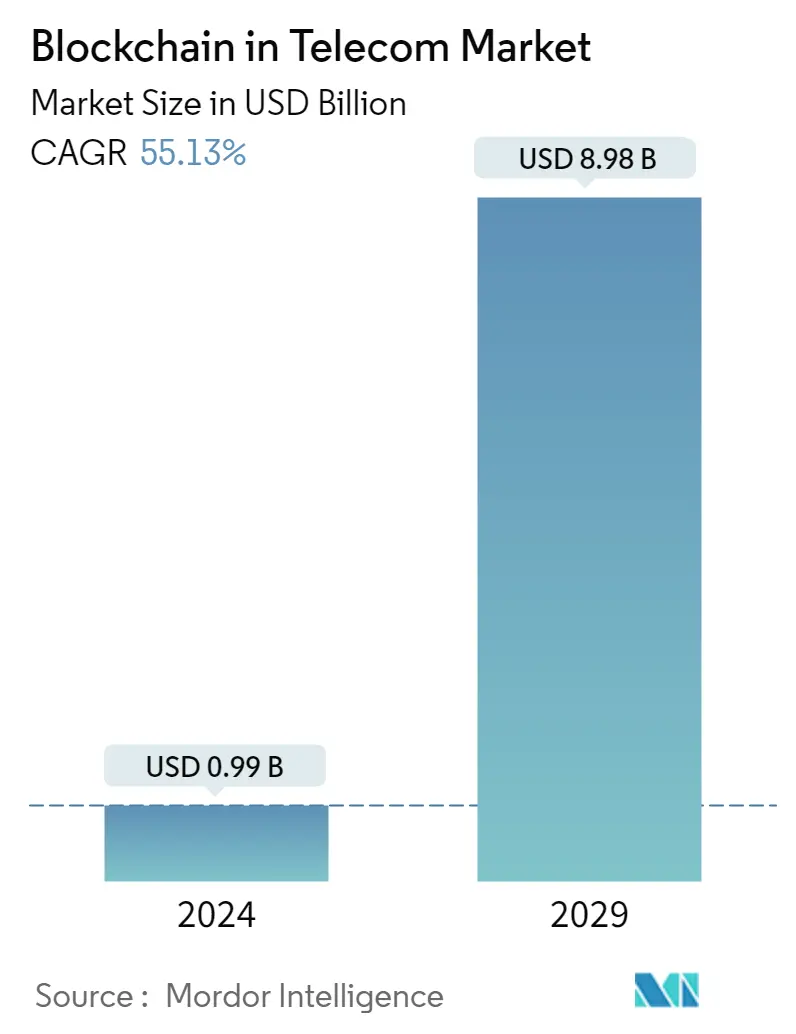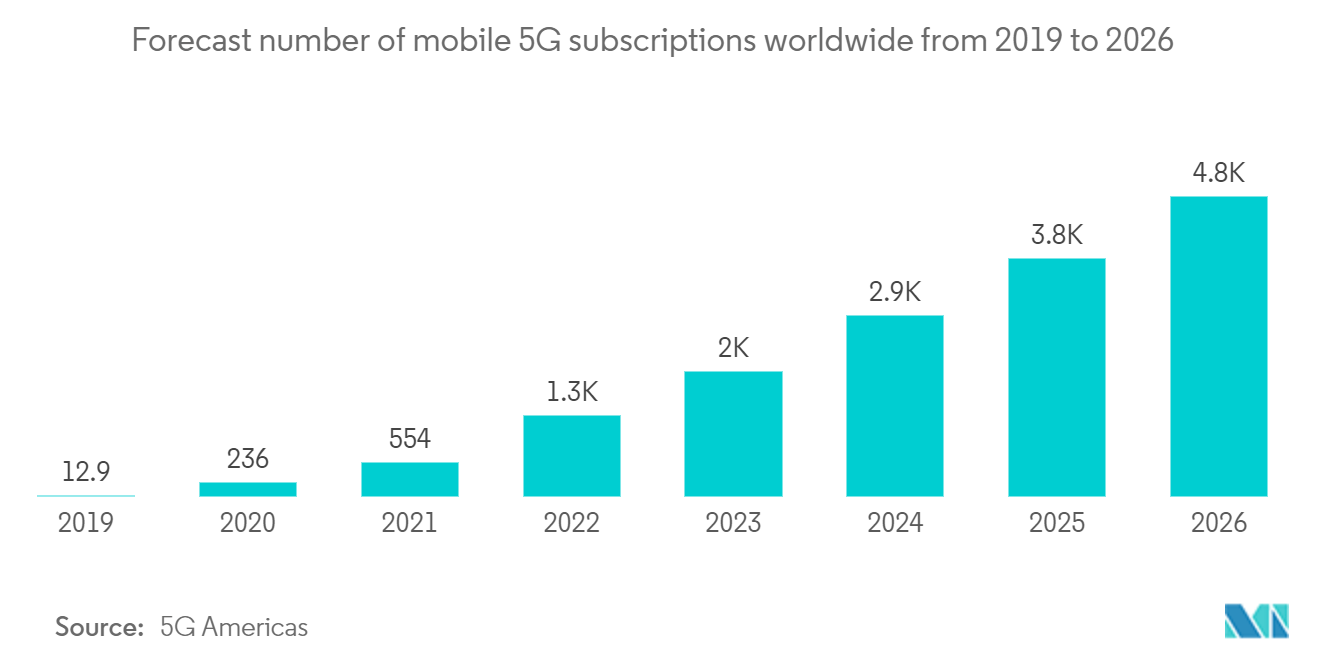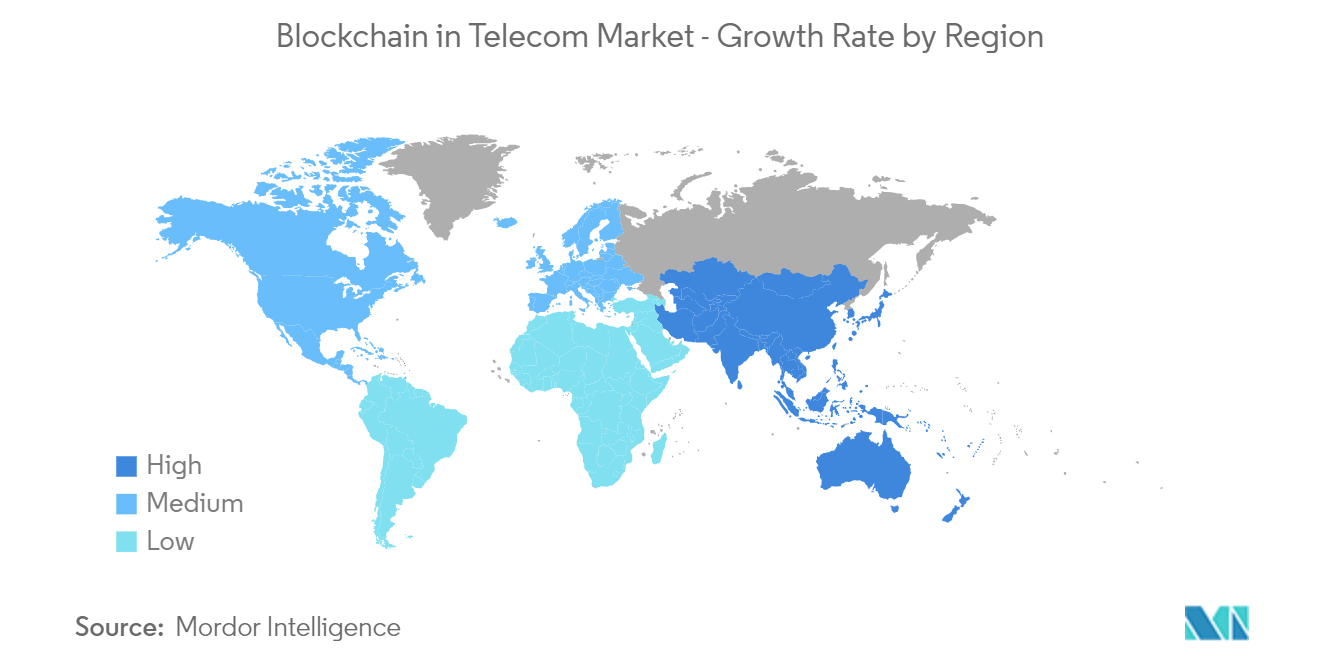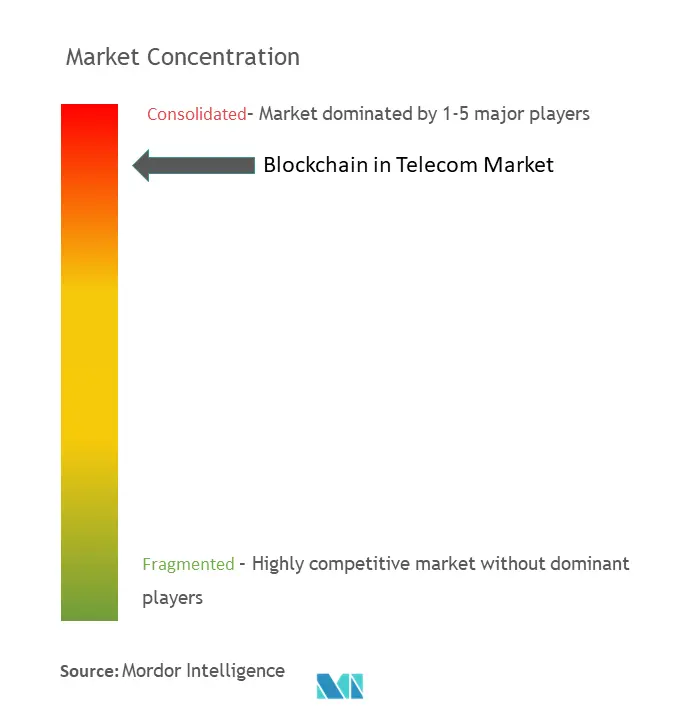Blockchain in Telecom Market Size

| Study Period | 2021 - 2029 |
| Market Size (2024) | USD 0.99 Billion |
| Market Size (2029) | USD 8.98 Billion |
| CAGR (2024 - 2029) | 55.13 % |
| Fastest Growing Market | Asia Pacific |
| Largest Market | North America |
Major Players
*Disclaimer: Major Players sorted in no particular order |
Blockchain in Telecom Market Analysis
The Blockchain in Telecom Market size is estimated at USD 0.99 billion in 2024, and is expected to reach USD 8.98 billion by 2029, growing at a CAGR of 55.13% during the forecast period (2024-2029).
In the telecom industry, blockchain plays a very significant role in preventing fraud, securing user identities, and supporting next-generation network services and IoT connectivity solutions, which in turn is driving the market significantly.
- The increasing adoption of 5G is a catalyst for blockchain implementation in telecom, as 5G is helping in quick and reliable blockchain operations. Blockchain technology provides robust encryption to record and store the data on the network in a more secure and verifiable way. It makes the information transparent and tamper-proof. Thus, Blockchain technology is expected to help various telecom companies boost their network security and reduce operational costs, driving the market's growth.
- Moreover, telecommunications or telecom fraud is a fast-growing field of criminal activity. According to Europol's European Cybercrime Centre and Trend Micro, telecom fraud costs around USD 32.7 billion annually. It represents a new challenge for law enforcement agencies. Blockchain can help in fraud detection and prevention for communication service providers, exponentially fueling the market's growth.
- Furthermore, in emerging countries such as India, the effectiveness of telecom regulator's deployment of blockchain technology for curbing spam SMSs has set an example for the government to build a transparent and trustworthy framework for various critical use cases such as Aadhar authentication, property, and vehicle ownership records and direct tax collection among others. In March last year, the Ministry of Electronics and IT released a draft policy on blockchain technology to regulate its deployment in various public and private use cases. The telecom regulatory authority of India (TRAI) has also deployed distributor-ledger technology (DLT), which is currently one of the most significant use cases of blockchain technology to control spam SMS traffic.
- However, on the other hand, scalability and interoperability are the several critical factors necessary for the overall adoption of blockchain technology. This is only possible when industry standards are set, which is at a lagging phase. The Telecom sector needs help with the mass adoption of blockchain technology, which can hinder the market's growth.
- The onset of the pandemic has highlighted the criticality of telecom infrastructure. The global health emergency is placing new pressures on telecom services and suggesting a pivotal role they can play beyond simple connectivity in emergency scenarios. Beyond the coronavirus pandemic, the world is expected to see substantial interest in new fintech services as the growing demand for virtual and online services continues to build. Within the telecommunications industry, the pandemic is driving the need for expanding digital infrastructure and data-driven services. Telecom companies increasingly focus on network resiliency and reliability, particularly in 5G investments.
Blockchain in Telecom Market Trends
This section covers the major market trends shaping the Blockchain in Telecom Market according to our research experts:
Smart Contract to Dominate the Market
- Smart contracts allow computer code to execute when specific conditions are met. The telecom industry is expected to witness significant adoption as it provides scope for automation in its internal operations, like billing, supply chain management, and roaming.
- Deploying smart contracts to manage all the billing related to roaming can lead to significant cost savings, as it provides prevention against fraudulent traffic. Blockchain can also add value to identity management solutions by cutting out intermediaries through smart contracts. This helps reduce roaming frauds, cost savings, and instant settlements. It helps telecom players to resolve disputes quickly through tamper-proof verifiable transactions and real-time updates to end customers.
- In March 2022, STC Bahrain introduced its official Chainlink node, which intends to offer smart contracts with access to a secure source of real-world data and fast off-chain computations. This makes STC Bahrain the first major telecom in the Middle East and North Africa (MENA) region to introduce a Chainlink node, enhancing the development of the smart contract ecosystem both in the area and throughout the globe.
- Moreover, 5G technology is one of the significant instances of how blockchain would change the telecommunication industry. For instance, in 5G technology, smart contracts can streamline the overall provisioning between the end user and the networks with a blockchain-based solution. For 5G to be implemented securely, the data received by connected devices must be reliable and free from various malicious interference. Further, to enable 5G to reach its full potential and protect against large-scale security breaches, blockchain can deliver decentralized, tamper-proof, and real-time verification of data transmission.
- As per 5G Americas, Solid growth in 5G subscriptions is expected to continue into the foreseeable future, reaching 5 billion subscriptions by the end of 2026. That includes the overall development of 700 million subscriptions from the current to next year and 900 million by next-to-next year.

Asia Pacific to Witness the Highest Growth
- The Asia-Pacific region boasts tremendous potential for the market, primarily owing to the growing prominence of mobile payments in countries such as India and China. India, specifically after the demonetization scheme, has witnessed many telecom operators shifting toward this model. For instance, Jio and Airtel, the country's leading telcos, offer digital wallets to enable customer-to-customer payments. Thus, the adoption of blockchain to handle the transactions by these companies could make their wallets more secure and cheaper, driving the market significantly.
- China Telecom, China Mobile, and China Unicom have joined the CAICT's Trusted Blockchain Initiative, which would use blockchain technology to bolster operations and security in the telecom industry. The companies are expected to focus on blockchain-based apps that relate to IoT data sharing and customer identity verification.
- Further, as the world is currently embroiled in a privacy debate over WhatsApp's policy changes, India's communication platform as a service (CPaaS) industry has been gearing up for the adoption of end-to-end encryption of commercial mobile SMSes, emails, and all other types of business communication between the enterprises and service providers.
- For instance, next year, CPaaS provider Tanla Platforms, in partnership with Microsoft, launched its edge-to-edge global blockchain network called Wisely, which was made for sending encrypted SMSes directly from enterprises to the telecom operators, which the company also claims to disrupt the existing aggregator model of commercial communication.
- In Japan, too, startups are developing blockchain solutions that enable secure smartphone-based money transfers that do not require formal banking documentation. For instance, a Japanese startup Telcoin leverages blockchain to facilitate telecommunication operators to provide money transfer services. Telcoin Wallet, built on the Ethereum blockchain, allows mobile users to make global transfers instantly, irrespective of local mobile service providers. Hence, adopting a standardized blockchain platform will help operators fully realize the technology's value and pave the path for faster adoption within the region, driving the market's growth significantly.

Blockchain in Telecom Industry Overview
The market is concentrated, with few significant vendors offering blockchain solutions across the telecommunication industry. The vendors are also receiving investors' funds, further helping in innovative blockchain services.
- November 2022 - Information technology (IT) services firm Tech Mahindra and telecom analytics solutions provider Subex have joined hands to roll out blockchain-based solutions for telecom operators globally. These solutions would mitigate fraud and drive operational efficiencies for communication service providers (CSP) by minimizing overall compliance issues.
- February 2022 - Bharti Airtel, India's premier communications solutions provider, declared that it had acquired a strategic stake in Aqilliz, a Blockchain as a Service Company under the Airtel Startup Accelerator Program, subject to applicable statutory approvals. Airtel aims to deploy Aqilliz's advanced blockchain technologies at a larger scale across its fast-growing Adtech, Digital Entertainment, and various Digital Marketplace offerings.
Blockchain in Telecom Market Leaders
-
Blockchain Foundry Inc.
-
Huawei Technologies Co., Ltd
-
Microsoft Corporation
-
Oracle Corporation
-
SAP SE
*Disclaimer: Major Players sorted in no particular order

Blockchain in Telecom Market News
- November 2022 - In collaboration with TSPs, Trai intended to bring new blockchain tech to curb spam calls and messages. It is working on various technologies to detect spam calls and messages using blockchain technology. Along with this, the regulator is taking action to form a joint committee of regulators (JCOR) consisting of the Telecom Regulatory Authority of India (Trai), Reserve Bank of India (RBI), Securities & Exchanges Board of India (SEBI), and the ministry of consumer affairs (MoCA).
- February 2022 - Global Telecom, an innovator in wireless technology engineering at the intersection of hardware and the network, declared the release of its MERCURY series of tri-connectivity modules, the first custom-designed modules allowing connectivity to satellite, cellular and private networks, plus Wi-Fi and Bluetooth. Global Telecom's MERCURY series are the first modules to enable connectivity to all three wireless networks, plus Wi-Fi and Bluetooth. It has about 100% custom-designed modules that feature patented, hostless, driverless tech with an added layer of blockchain security.
Blockchain in Telecom Market Report - Table of Contents
1. INTRODUCTION
- 1.1 Study Assumptions and Market Definition
- 1.2 Scope of the Study
2. RESEARCH METHODOLOGY
3. EXECUTIVE SUMMARY
4. MARKET DYNAMICS
- 4.1 Market Overview
-
4.2 Industry Attractiveness - Porter's Five Forces Analysis
- 4.2.1 Threat of New Entrants
- 4.2.2 Bargaining Power of Buyers/Consumers
- 4.2.3 Bargaining Power of Suppliers
- 4.2.4 Threat of Substitute Products
- 4.2.5 Intensity of Competitive Rivalry
- 4.3 Assessment of COVID-19 impact on the industry
5. MARKET DYNAMICS
-
5.1 Market Drivers
- 5.1.1 Focus on Telecom Fraud Detection and Prevention is Driving the Market Growth
-
5.2 Market Restraints
- 5.2.1 Lack of Industry Standards
6. MARKET SEGMENTATION
-
6.1 Application
- 6.1.1 Identity Management
- 6.1.2 Payment and Billing
- 6.1.3 Smart Contract
- 6.1.4 Connectivity Provisioning
-
6.2 Geography
- 6.2.1 North America
- 6.2.2 Europe
- 6.2.3 Asia Pacific
- 6.2.4 Rest of the World
7. COMPETITIVE LANDSCAPE
-
7.1 Company Profiles
- 7.1.1 Blockchain Foundry Inc.
- 7.1.2 Huawei Technologies Co. Ltd.
- 7.1.3 Microsoft Corporation
- 7.1.4 Oracle Corporation
- 7.1.5 SAP SE
- 7.1.6 ShoCard Inc. (Ping Identity)
- *List Not Exhaustive
8. INVESTMENT ANALYSIS
9. FUTURE OF THE MARKET
** Subject To AvailablityBlockchain in Telecom Industry Segmentation
Communication service providers control the end-to-end value chain (data connectivity), network infrastructure, and other consumer services for users and businesses. Thus, the need to find new sources of revenue and reduce costs is more than ever, as income is decreasing due to factors such as high cost and high bandwidth demand. Thus, blockchain provides the capability to influence the core management system of CSPs by creating an ecosystem where cost can be reduced, and revenue can be increased with efficiency.
The Blockchain in Telecom Market is segmented by Application (Identity Management, Payment and Billing, Smart Contract, Connectivity Provisioning) and Geography (North America, Europe, Asia-Pacific, Rest of the World). The market sizes and forecasts regarding value (USD million) for all the above segments are provided.
| Application | Identity Management |
| Payment and Billing | |
| Smart Contract | |
| Connectivity Provisioning | |
| Geography | North America |
| Europe | |
| Asia Pacific | |
| Rest of the World |
Blockchain in Telecom Market Research FAQs
How big is the Blockchain in Telecom Market?
The Blockchain in Telecom Market size is expected to reach USD 0.99 billion in 2024 and grow at a CAGR of 55.13% to reach USD 8.98 billion by 2029.
What is the current Blockchain in Telecom Market size?
In 2024, the Blockchain in Telecom Market size is expected to reach USD 0.99 billion.
Who are the key players in Blockchain in Telecom Market?
Blockchain Foundry Inc., Huawei Technologies Co., Ltd, Microsoft Corporation, Oracle Corporation and SAP SE are the major companies operating in the Blockchain in Telecom Market.
Which is the fastest growing region in Blockchain in Telecom Market?
Asia Pacific is estimated to grow at the highest CAGR over the forecast period (2024-2029).
Which region has the biggest share in Blockchain in Telecom Market?
In 2024, the North America accounts for the largest market share in Blockchain in Telecom Market.
What years does this Blockchain in Telecom Market cover, and what was the market size in 2023?
In 2023, the Blockchain in Telecom Market size was estimated at USD 0.64 billion. The report covers the Blockchain in Telecom Market historical market size for years: 2021, 2022 and 2023. The report also forecasts the Blockchain in Telecom Market size for years: 2024, 2025, 2026, 2027, 2028 and 2029.
Blockchain in Telecommunication Industry Report
Statistics for the 2023 Blockchain in Telecommunication market share, size and revenue growth rate, created by Mordor Intelligence™ Industry Reports. Blockchain in Telecommunication analysis includes a market forecast outlook to 2029 and historical overview. Get a sample of this industry analysis as a free report PDF download.



